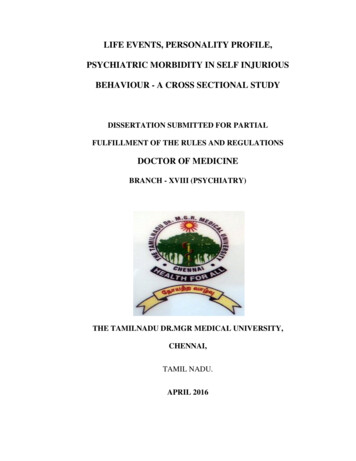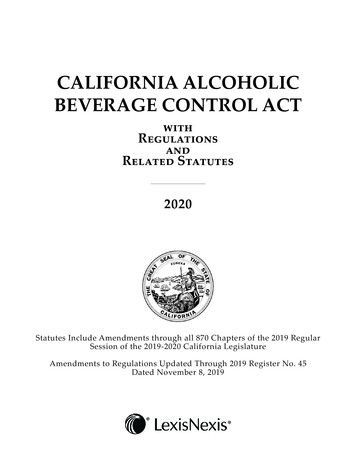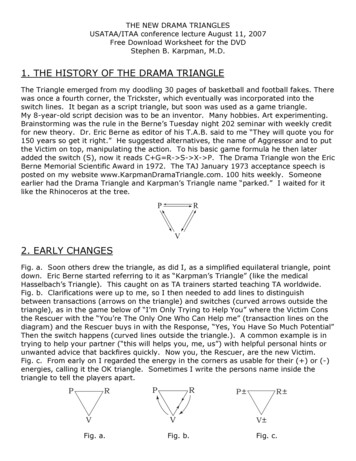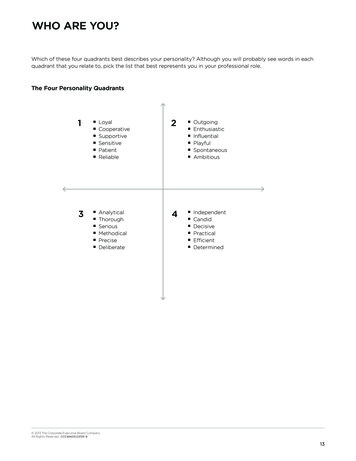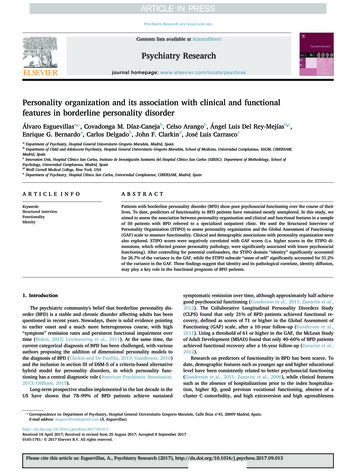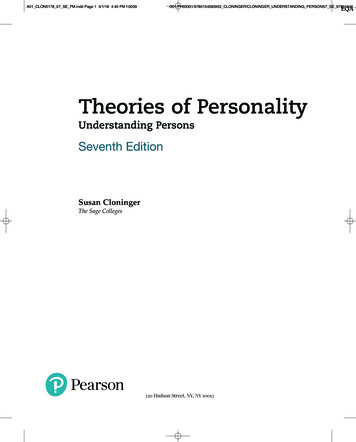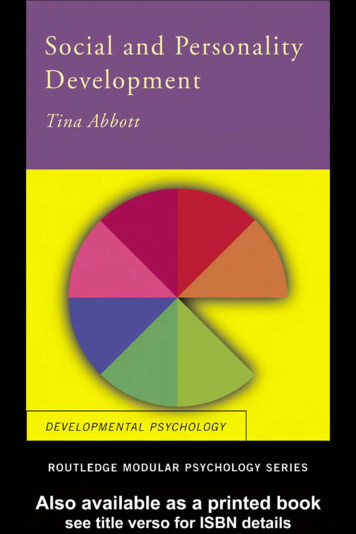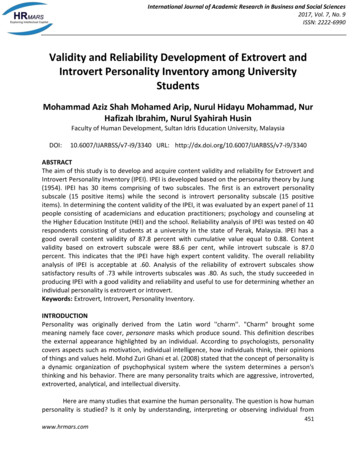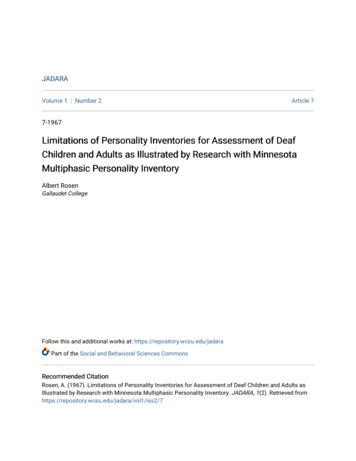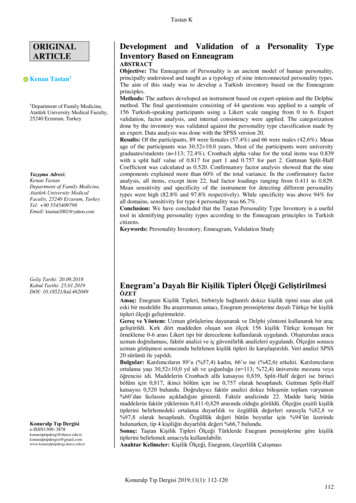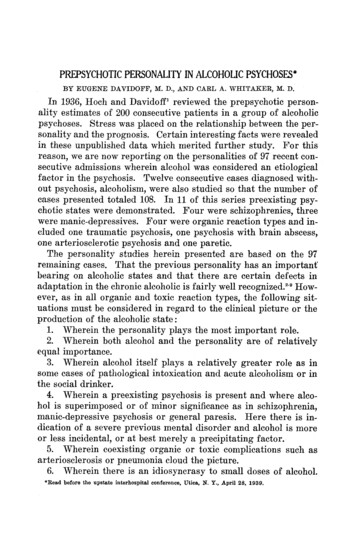
Transcription
PREPSYCHOTIC PERSONALITY IN ALCOHOLIC PSYCHOSES*B Y E U G E N E DAVIDOFF, M. D., AND CARL A. WHITA KER, M. D.In 1936, Hoch and Davidoff" reviewed the prepsychotic personality estimates of 200 consecutive patients in a group of alcoholicpsychoses. Stress was placed on the relationship between the personality and the prognosis. Certain interesting facts were revealedin these unpublished data which merited f u r t h e r study. F o r thisreason, we are now reporting on the personalities of 97 recent consecutive admissions wherein alcohol was considered an etiologicalfactor in the psychosis. Twelve consecutive cases diagnosed without psychosis, alcoholism, were also studied so that the number ofcases presented totaled 108. In 11 of this series preexisting psychotic states were demonstrated. F o u r were schizophrenics, threewere manic-depressives. F o u r were organic reaction types and included one traumatic psychosis, one psychosis with brain abscess,one arteriosclerotic psychosis and one paretic.The personality studies herein presented are based on the 97remaining cases. That the previous personality has an important'bearing on alcoholic states and that there are certain defects inadaptation in the chronic alcoholic is fairly well recognized. "9 However, as in all organic and toxic reaction types, the following situations must be considered in r e g a r d to the clinical picture or theproduction of the alcoholic state:1. Wherein the personality plays the most important role.2. Wherein both alcohol and the personality are of relativelyequal importance.3. Wherein alcohol itself plays a relatively g r e a t e r role as insome cases of pathological intoxication and acute alcoholism or inthe social drinker.4. Wherein a preexisting psychosis is present and where alcohol is superimposed or of minor significance as in schizophrenia,manic-depressive psychosis or general paresis. H e r e there is indication of a severe previous mental disorder and alcohol is moreor less incidental, or at best merely a precipitating f a c t o r .5. Wherein coexisting organic or toxic complications such asarteriosclerosis or pneumonia cloud the picture.6. Wherein there is an idiosyncrasy to small doses of alcohol.*Read before the upstate interhospital conference, Utica, N. Y., April 28, 1939.
104PREPSYCHOTIC PERSONALITY IN ALCOHOLIC PSYCHOSESWhile types 1 and 2 predominated in the series, in general it maybe said that in the more acute phases of the alcoholic psychoses,the alcohol itself is relatively more prominent in the symptomatology, although the total personality is of course important. Inthe more chronic phases of the alcoholic psychoses, the personalityassumes a major role. However, it appeared from our materialthat almost all alcoholic psychoses, even the acute phases, are preceded by relatively long periods of chronic alcoholic addiction andthat these psychoses occur in individuals with more or less severeadaptive and integrative defects.The classification followed is that adopted by the American Psychiatric Association. There were 37 cases of pathological intoxication, 15 cases of delirium tremens, 4 of Korsakow's psychosis, 8 ofacute hallucinosis; there were also 21 protracted cases termed" o t h e r types," including 12 deteriorating cases, 5 with pseudoparesis and 4 with paranoid trends.There were 12 cases classified without psychosis, alcoholism, asnoted above. It is probably well to point out too, that the chronicalcoholics without psychosis seen at the Syracuse PsychopathicHospital are of rather severe and protracted type.At first, a broad survey based on extraverted and introvertedtendencies similar to the one employed by Hoch and Davidoff intheir report on traumatic psychoses 1 and in their unpublished dataon alcoholic psychoses was used. This was formulated in accordance with the predominating attitude of the individual in meetinglife situations and was based on the personality studies containedin the guide and outline for psychiatric examination of the Department of Mental Hygiene.". isThe findings are indicated in Table 1. In the more serious formsof acute hallucinosis and in the deteriorating types, the introvertspredominated. In the acute types including the delirium tremensgroup, and the cases designated as pathological intoxication wherethe effects noted are more directly the result of the toxic process,more extraverts were found. In the deteriorating group, it wasnoted that eight of the introverted personalities had recently beenin this hospital with a diagnosis of chronic alcoholism, without psychosis. This rapid retrograde " c h a n g e " occurred in only one ofthe extraverted chronic alcoholics. Seven of the introverts were
E U G E N E DAVIDOFF, 1VI. D. 3 AND CARL A. W H I T A K E R , ]Yl. D.105committed for continued treatment to State hospitals while onlythree extraverts were thus allocated.TABLE 1IntrovertsW i t h o u t psychosis (chronic and acute alcoholic s t a t e s )Pathological intoxication . . . . . . . . . . . . . . . . . . . . . . . . . .Delirium t r e m e n s . . . . . . . . . . . . . . . . . . . . . . . . . . . . . . . . .Acute hallucinosis . . . . . . . . . . . . . . . . . . . . . . . . . . . . . . . .K o r s a k o w ' s psychosis . . . . . . . . . . . . . . . . . . . . . . . . . . . . .Other types ( p r o t r a c t e d f o r m s )Deteriorating . . . . . . . . . . . . . . . . . . . . . . . . . . . . . . . . .Paranoid . . . . . . . . .Pseudoparetic . . . . . . . . . . . . . . . . . . . . . . . . . . . . . . . 4797In order to obtain a more intimate knowledge of, and to delineate more minutely, the prepsychotic personality traits exhibited byindividuals in whom alcoholic psychoses developed, the case recordswere carefully studied for more specific characteristics describedin the biographies and occurring prior to their state of chronic alcoholism. These traits and etiological factors in the 97 cases, recounted in the life history, are listed in the order of their frequencyof occurrence in Table 2. The chronic alcoholics without psychosis were includcd because the defects noted closely paralleled thosedescribed in the psychotic group. As pointed out above, 9 of the21 cases with protracted alcoholic psychoses had previously beenin the hospital with a diagnosis of chronic alcoholism, without psychosis. Further, 12 cases of pathological intoxication and six casesof delirium tremens had been diagnosed similarly at the time ofanother admission. In the 21 protracted cases, 13 psychopathicpersonalities were encountered. It is at times difficult to differentiate between chronic alcoholism and alcoholic psychoses. The linebetween an episode of acute inebriation in a chronic alcoholic and atrue pathological intoxication is often finely drawn.In the group listed as "reacting poorly to change of state" weincluded those individuals who are frequently described under theheading of simple adult or social maladjustment. These patientsin the critical transition periods of their early life, in the changefrom infancy to childhood, from childhood to puberty, from pubertyto manhood and from the single state to the married state continue
106P R E P S Y C H O T I C P E R S O N A L I T Y I N ALCOHOLIC P S Y C H O S E Sto exhibit significant immature characteristics retained from theprevious periods. These include: strong oral, anal, narcissistic orlatent homosexual traits, irresponsibility, wish-fulfillment and thedesire for more easily sought after gratifications which rendertheir mature adjustment a doubtful and precarious matter.TABLE 2,PERSONALITY TRAITSP o o r reaction to change of state or simple adult m a l a d j u s t m e n tI m m a t u r e sexuality . . . . . . . . . . . . . . . . . . . . . . . . . . . . . . . . . . . . . . .Marital difficulties . . . . . . . . . . . . . . . . . . . . . . . . . . . . . . . . . . . . . . . .Circumscribed r a n g e o interests . . . . . . . . . . . . . . . . . . . . . . . . . . . .Irritability .Psychopathic t r a i t s with i n s t a b i l i t y . . . . . . . . . . . . . . . . . . . . . .Psychoneurotic t r a i t s . . . . . . . . . . . . . . . . . . . . . . . . . . . . . . . . . . . . . .Narcissism and s t r o n g self-preservative t r a i t s . . . . . . . . . . . . . . . .Dependency . . . . . . . . . . . . . .Mother a t t a c h m e n t . . . . . . . . . . . . . . . . . . . . . . . . . . . . . . . . . . . . . . . .A b n o r m a l reaction to f a i l u r e . . . . . . . . . . . . . . . . . . . . . . . . . . . . . . .F a m i l y and financial worries . . . . . . . . . . . . . . . . . . . . . . . . . . . . . . .Sadomasochistic t r a i t s (sadistic 17; masochistic 13) . . . . . . . . . .P o o r social a d a p t a b i l i t y . . . . . . . . . . . . . . . . . . . . . . . . . . . . . . . . . . .Depressive moods . . . . . . . . . . . . . . . . . . . . . . . . . . . . . . . . . . . . . . . . .L a t e n t homosexual t r a i t s or tendencies . . . . . . . . . . . . . . . . . . . . . .P a r a n o i d bias . . . . . . . . . . . . . . . . . . . . . . . . . . . . . . . . . . . . . . . . . . . .Compulsive states . . . . . . . . . . . . . . . . . . . . . . . . . . . . . . . . . . . . . . . . .Feelings of i n f e r i o r i t y . . . . . . . . . . . . . . . . . . . . . . . . . . . . . . . . . . . .Father antagonism . . . . . . . . . . . . . . . . . . . . . . . . . . . . . . . . . . . . . . . .Failure of compensatory f a c t o r s . . . . . . . . . . . . . . . . . . . . . . . . . . . .Restricted sex outlets or deprivation of loved object . . . . . . . . . .Repressive t r a i t s . . . . . . . . . . . . . . . . . . . . . . . . . . . . . . . . . . . . . . . . . .Sibling rivalry or spoiled child reaction . . . . . . . . . . . . . . . . . . . . .Suggestibility . . . . . . . . . . . . . . . . . . . . . . . . . . . . . . . . . . . . . . . . . . . .I m p o t e n c e or f e a r of impotence . . . . . . . . . . . . . . . . . . . . . . . . . . . .H y p o m a n i c tendencies . . . . . . . . . . . . . . . . . . . . . . . . . . . . . . . . . . . . .Mental deficiency . . . . . . . . . . . . . . . . . . . . . . . . . . . . . . . . . . . . . . . . .S y m p a t h y - g e t t i n g devices . . . . . . . . . . . . . . . . . . . . . . . . . . . . . . . . .Organic complications . . . . . . . . . . . . . . . . . . . . . . . . . . . . . . . . . . . . .Overt homosexuality . . . . . . . . . . . . . . . . . . . . . . . . . . . . . . . . . . . . . .Married . . . . . . . . . 74Single . . . . . . . . . 612i2126643N o t e : I n the fiscal year ended J u n e 30 1938, the first admissions to S t a t e hospitalswith alcoholic psychoses comprised 679 males and 152 females.13The various characteristics listed under this heading includedlaziness, lack of initiative, apathy, ineffectuality, confusion in andinability to meet new situations, or on the other hand, more or less
EUGENED A V I D O F F ' 3 lY[. D . , A N D C A R L A. W H I T A K E R ,l I. D .107marked reaction to feelings of guilt, tenseness and inability to relax. Other traits found are failure to take advantage of opportunities and work adjustment which is not commensurate with theopportunities offered or the preparation and training they havehad. The frequent changing of jobs or the seeking of " s o f t " jobswith a tendency toward routine, dependent tasks, frequent evasionof responsibility accompanied by complaining and querulousnessover inconsequentialities, lack of hobbies and creative interest, narrowed and rigid outlooks on life with circumscribed range of v i s i o nand restricted range of interests, a tendency to live from day today, a pervading feeling of emptiness and boredom, a lack of driveand inclination to reminiscence or daydreaming were the characteristics found in this subgroup.The mechanisms in the psychoneurotic and the psychopathicdrinker are closely allied. There are those who crave alcohol toprovide a stimulus either to escape their boredom or feelings ofguilt or to produce an unreal impetus to their repressed, unutilizedc eative urges. Occasional unsustained spurts of brilliance arisebut in reaction to change of state these individuals revert to moreinfantile and more primitive methods of gratification and adaptation. They cannot integrate their feelings of guilt constructively.Alcohol "stupifies," allays the conflict and aids in carrying themback to these earlier methods of adaptation in their search to recapture the past. Occasionally they became wanderers or transients. Many of these traits occur in psychoneurotics and in psychopaths who do not drink.One type of psychopathic drinker often denies the use of alcoholbecause of an apparent superficial conscious fear of community andsocial censure. He is only dimly aware of the causes of his alcoholism. He continues to drink because of his unconscious desireto punish himself in regard to these feelings of guilt. He wouldrather castigate himself for these hidden, unpleasant, unconsciouscravings than have an outside authority punish him for alcoholism.He conceals the deep-seated guilt from his conscious self and it istherefore not so apparent to him as his conscious rationalized guilt,that is, alcoholism, which he seeks to conceal from society. Here,the unconscious guilt so far as the individual is concerned, is a*One of the patients w a s a g r a d u a t e of the Massachusetts Institute of Technc logy b u t w o r k e d f o rseveral y e a r s as a f a c t o r y hand.
108PREPSYCHOTIC PERSONALITY IN ALCOHOLIC PSYCHOSE greater guilt, while the conscious guilt to him is secondary. However, on the surface, and in his apparent explanation to society, hewould make it appear that the opposite situation exists. This typeof individual frequently denies and " f o r g e t s " what he has doneduring an alcoholic debauch, and insists upon the fact that he iswell thought of in his community, or projects his difficulties on thecommunity.Another type of psychopathic drinker attempts to impress youwith the fact that he committed these antisocial acts only becausehe drank. Here the feelings of guilt are released by the alcohol,which serves as a means of escape or as an unconscious excuse foryielding to lower center cravings. Alcohol then is utilized as asubstitute for strong unconscious urges not so well concealed fromthe person imbibing. He consciously censures and feels ashamedof these. He would rather be punished by authority for his alcoholism than have others aware of these strong urges which werenot concealed from him. Here, the conscious guilt, insofar as theperson himself is concerned, is the more primary one, and in realitythe greater and unconscious guilt is the secondary or lesser guilt.Still, superficially, and in his apparent explanation to society itwould seem that the opposite situation exists. The first type deceives himself as well as society, while the second type attempts todeceive only society, and is more aware of the unconscious urgeswhich he will continue to use in his adaptation.While every psychopathic personality and psychoneurotic doesnot drink, psychoneurotic and psychopathic traits occur frequentlyin the prepsychotic personality. Psychopathic and psychoneuroticdrinkers offer a great challenge not only as regards their adjustment but also with respect to the concept of chronic alcoholism. Itis often difficult to decide whether a given alcoholic presents a definite psychoneurosis or whether psychoneurotic traits are presentwhich predispose to the alcoholic state. The same considerationapplies in the psychopathic group. In a larger series of chronicalcoholics without psychosis, we have found it difficult to decidewhether either a diagnosis of psychoneurosis or psychopathic personality or chronic alcoholism would better describe the patient. Insix of the 12 cases of chronic alcoholism, a diagnosis of psychopathic personality or psychoneurosis would have been equally ten-
EUGENE DAVIDOFFj lY[. D. AND CARL A. WItITAKER iY[. D.109able, so that the alcoholism may have been only a manifestation of asevere psychoneurotic or psychopathic state. The psychoneuroticdrinkers herein described are usually the moody, depressive, anxious and compulsive types. The psychopathic drinkers are usuallyunstable or schizoid.In regard to hypomanic tendencies or depressive moods, it is ofttimes difficult to decide whether one is dealing with a true cyclothymic reaction or whether these latent tendencies are released byalcohol. In a few of these cases a true manic-depressive reactionhad to be seriously considered. On the other hand, in the three ofthe 11 cases with preexisting psychoses (nOted above as belongingto the manic-depressive group) alcoholism, although considered ascontributory by us, might with some reason be recognized as a moreimportant factor in the production of the psychosis. However,where alcohol was the direct precipitating factor in producing characteristic acute phases of the symptomatology such as deliriumtremens, we preferred the diagnosis of alcoholic psychosis. Wherethe preexisting psychosis was proven to be present prior to recentconsumption of alcohol we preferred the diagnosis of manic-depressive reaction.The alcoholic individual often uses alcohol not merely to escapefrom, but also to defer the appearance of more severe personalitydifficulties. In the group of 11 cases, where preexisting psychoseswere present, four of whom were schizophrenics, the symptomswere released by alcohol. Among the more severe protracted groupof alcoholic psychoses and in chronic alcoholism, a predominance ofintroverted and psychopathic personalities was noted. The question arises, therefore, whether there is any significant difference between the two groups, except that the alcoholic state releases, or isa manifestation of the deep-seated schizophrenic process in theformer group. True, it masks and defers, but it finally contributesto the release of symptoms in the introverted psychopathic personality type. Nor can this be disregarded in the paranoid types, inthe more chronic cases of auditory hallucinosis and in those typesshowing deterioration of the personality.The primarily extraverted alcoholic drinks because actual situations in the environment become too hard to face and he attemptsto "shut reality out." He then uses alcohol to release his compen-
110PREPSYCHOTIC PERSOI IALITu I N ALCOHOLIC PSYCHOSESsatory or secondary introverted tendencies, and retreats into, andseeks satisfaction from, his own phantasies and cravings. In thatway he escapes the environmental situations and the dictates of thesuperego which he finds difficult to face.The introverted drinker indulges in alcohol because of his primary tendencies to evade reality, seeking satisfaction in the moreprimitive cravings arising within himself. When these unconsciousurges begin to disturb him or are found unsatisfactory or unadaptable, he seeks to escape them but it is difficult for him to face theenvironmental forces in a natural manner. He then employs alcohol to remove the primary introverted tendencies--the so-called release of inhibition and the secondary extraverted tendency. Sincealcohol is an artificial stimulant (in reality a depressant of thehigher cortical functions) it accomplishes this purpose only temporarily and in the long run carries the introverted personalityfurther away from reality. It removes the superego and finallyreleases the stronger more primitive, primary, introverted, regressive tendencies. However, at first, he becomes dependent on alcohol in his abortive attempt to meet reality. In the true schizophrenic these primitive urges are more strongly concealed from thetotal personality and there is apparently less effort to escape fromthe regressive tendency.Therefore, alcohol may precipitate a severe personality reactionin a person with predisposed psychoneurotic or psychopathic traits,or in a maladjusted schizoid or maladjusted extravert alcoholismmay be a manifestation of the adaptation of that type of personality with an attempt on his part to escape or mask the tendencies. When compensatory factors fail alcohol releases first anacute toxic process or clouded state which pervades the picture. Ifthe process continues, the toxic features tend to disappear and themore severe personality disorders come to the fore. However, itcannot be denied that excessive alcoholism in itself may produce organic deterioration which is partially although not wholly independent of the personality pattern, and may alter the personalitypattern regressively, particularly in poorly-integrated individualswho lack compensatory powers.It seems to us that there is a need for a subdivision in the groupof alcoholic psychoses, to be designated as alcoholic personality dis-
EUGENEDAVIDOFF, lYl.D., A N D C A R L A. W H I T A K E R i I.D.iiiorders. In this group, both factors are at first combined but thepersonality factors finally outweigh the alcoholic toxic effects in determining the course and the regressive personality alterations aremore evident. Many of the cases included in the chronic alcoholicgroup without psychosis might, if more minutely studied, fall morep r o p e r l y into this subclassification of the alcoholic psychoses.I n eight cases where organic or severe toxic factors complicatedthe picture or were preexistent the course was more p r o t r a c t e d andthe prognosis more guarded. Deterioration of such mental processes as the sensorium, mental grasp and thinking capacity, ismore likely to occur in this type, p a r t i c u l a r l y where the plasticityof the personality is lessened.Confirmation of some of these observations has been f o u n d in theadministration of amphetamine (Benzedrine Sulfate) to a numberof the patients herein described. Their reactions to this d r u g indicated t h a t where the toxic alcoholic factors p r e d o m i n a t e d amphetamine was usually effective in allaying these symptoms. W h e r epersonality disorders or complicating organic processes predominated and where deterioration was in progress, the results werenot satisfactory. The presence of personality disorders m a y account for the ineffectiveness of a m p h e t a m i n e in the t r e a t m e n t ofchronic alcoholic addiction. 14* CASE ATERIAL The following are abstracts of case records demonstrating someof the points under discussion :Group I--Illustrative of the introverted drinkerCase 1. J. C., 39 years of age, diagnosis without psychosis, alcoholism.He had had three admissions within three years, with the same diagnosis.This patient was described as a rather quiet child who never caused anytrouble. As a youngster, he was bright but left school at an early age. Inhis earlier years he was much attached to his family. As he became older,he was considered to be selfish, seclusive, and did not want anyone near him.He had many relatives in Syracuse but lived alone i n a rooming housewhere he paid the rent irregularly but tried to "run everybody." He wasvery finicky, high strung, never confided in anyone and was resistive to explaining his movements. He never went out with women but preferred thecompany of his own sex. At times he became somewhat irritable and*We are indebted to EUnor S. Noetzel for some of the social service data contained in theseabstracts.
112P R E P S Y C H O T I C P E R S O N A L I T Y I N ALCOHOLIC P S Y C H O S E S" m e a n , " was annoyed at the landlady, her daughter and friends who cameto visit them, but would give no explanation for this. He was a carpenter,was considered a good worker but never held a steady job at this trade.He has been drinking for the past 10 years. He used to drink in the company of men but lately has been alone. Of late he became more abusivetoward his landlady, had been unemployed for a year prior to his firstadmission; stated that he did not like crowds because they made him nervous. At first, it was noted that drinking made him more friendly but ultimately he became more seclusive and abusive. He was married in 1932 butwas separated from his wife four months after their marriage.He was admitted to the hospital on each occasion because he had beendrinking heavily and had become abusive and noisy. No delusions or hallucinations were elicited, nor was there any confusion or amnesia. His I. Q.was average. He evaded questioning relative to why he came to the hospital, minimized his alcoholism and denied that he had been abusive. Onone occasion he stated that he came to the hospital to be cured, not to bequestioned. He quieted down soon after each admission, became quite cooperative but was never very friendly nor did he present a natural affect. Thiscase might well be considered for diagnosis under alcoholic personality disorder.Case 2. W . W . , 38 years of age, diagnosis dementia prmcox, catatonic.4Aways very much attached to his mother, W. W. never went out much,was quiet and seclusive, and overly religious. He was bright in the lowergrades but soon lost interest, did not care much about school and left whenin the sixth grade. He preferred the company of men, had no use forwomen, was very much devoted to his brother and displayed many latenthomosexual tendencies. H e worked irregularly as a skilled laborer butwhen he did work he was very competent. He had been drinking heavilyfor the past six years. He was admitted to the hospital because he wandered into a house, having broken the lock on the door, stated that hewanted to see the owner and then quietly walked out.On admission, he was confused and tended to assault. After his confusion cleared up he showed a marked religious trend, heard " t h e voice ofG o d" and at times saw "visions." He assumed peculiar positions and wasfound praying constantly. On the ward, he showed many homosexual tendencies and his behavior continued stereotyped and manneristic. Later, during his hospital residence, the auditory hallucinations began to disappearbut he continued impulsive, assaultive and surly, and demonstrated amarkedly inappropriate affect. Although he was admitted to the hospitalin an acute state of alcoholism, after the acute phase cleared up, he showed atypical catatonic picture.
EUGENE DAVIDOFF 1 I. D. AND CARL A. WHITAKER 1 . D.113Case 3. E. N., 46 years of age, diagnosis alcoholic psychosis, paranoidtype.E. N. had always been described as quiet, shut-in, not interested in peopleand appearing to have very little drive. He was bright, had no difficultyin school, attended college for three years and graduated from a school ofpharmacy but never owned a store of his own, nor did he work steadily forothers. He was attached to his mother and very dependent upon her hestudied pharmacy to please her. His mother was fanatically opposed topeople who drank. He was always finicky, particularly about his diet, andinsisted on eating exactly four eggs a day. Frequently he went on huntingand fishing trips by himself instead of working or finding recreation inthe company of his neighbors.The patient was admitted to this hospital from a general hospital in analcoholic stupor after a prolonged debauch. It was elicited that he had beendrinking more or less heavily for 10 years prior to this time. After he recovered consciousness and the confusion began to subside he became fearful,responded to auditory hallucinations and thought people were followinghim. Subsequently, the hallucinations lessened considerably but he continued paranoid and threatening toward physicians and nurses. He wasmore or less evasive and untruthful. He was quite suspicious of, and finickyin regard to, the hospital food. He finally admitted that he thought peoplewere against him and that his family physician was trying to harm him.His affect improved, however, but he remained more or less confused andsuspicious, requiring commitment.Group IIIllustrative of the extraverted drinkerCase 4. T.M., 39 years of age, diagnosis without psychosis, alcoholism.The patient's father was described as rather cross, irritable and exactingin regard to the patient but on good terms with him. The mother as well asthe patient had violent tantrums and the patient was overtly antagonistictoward her. The patient was always described as pleasant, congenial, a verygood mixer; "things came easily to h i m " but at times he was an unusuallyhard worker. However, he worked only in spurts. He was always an exceptional student, attended parochial schools, graduated from college at the ageof 19 and attended a university abroad. At one time he intended to study forthe priesthood but soon abandoned this plan. At college he played football,engaged in many sports, always liked to have a good time, had many friendsand was considered most "convivial."He was further described by those who knew him as having a winningpersonality, good social background and unusual educational opportunities.He was an accomplished pianist and has been able to secure work in this .--1940---
114PREPSYCHOTIC PERSONALITY I N ALCOHOLIC PSYCHOSEScapacity in cafes and beer gardens where he had ready access to alcoholicbeverages. He liked to impress people with his knowledge of Latin andGreek, and also delighted in recalling his university experiences.He married a woman of different faith than his and for a while they werevery happy and the patient did well financially. He worked as a salesmanfor various companies. However, for the past four or five years, the patienthas been unemployed. At first, he tried to sell vacuum cleaners, cars andother accessories but was not successful. He felt that these things were beneath his dignity and for the past five years has been drinking excessively.Lately his wife and he have not been getting along and he has accusedher of being frigid. He stated that he was too proud and
ality estimates of 200 consecutive patients in a group of alcoholic psychoses. . the introverts predominated. In the acute types including the delirium tremens . The frequent changing of jobs or the seeking of "soft" jobs

